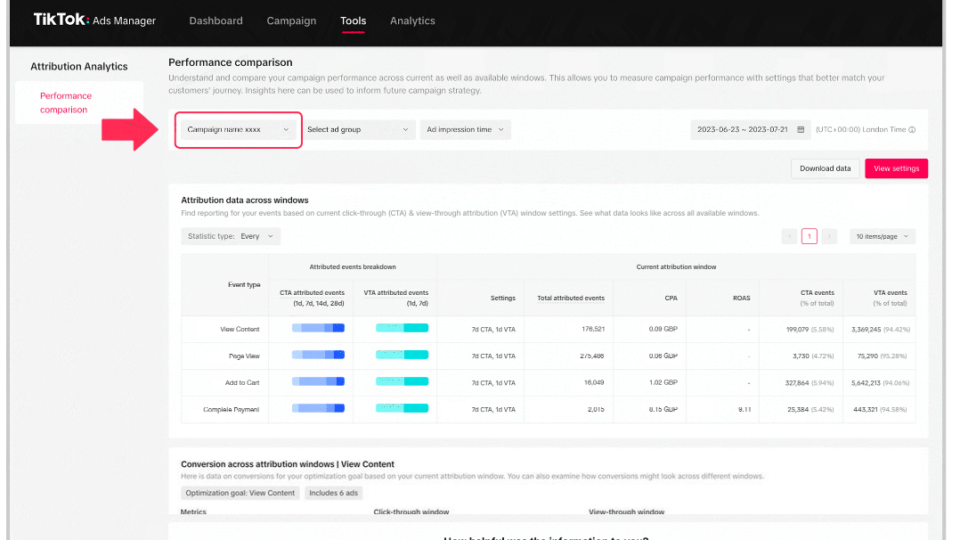TikTok Expands Measurement Suite with First-Party Solutions
TikTok has introduced Attribution Analytics, a first-party measuring tool made to assist marketing teams in comprehending the financial effects of the social network’s advertising solutions. Creating internet sensations is what the short-form content app is known for. The ByteDance-owned company is currently working to give advertisers more tangible tools to evaluate the impact of their campaigns on consumer spending. Other activities outside of the ingrained sorts of click-based measurement will also follow. Customers mostly see content that inspires them thanks to the TikTok feed’s immersive nature. However, it is possible that they might not act on that inspiration until much later. As a consequence, 79% of conversions that users attributed to TikTok were absent from conventional last-click attribution models.
TikTok’s New Measurement Capabilities.
According to TikTok, the majority of talks that could be attributed to in-app exposure aren’t recorded. This is a result of the way users use the app: browsing during a live session, then browsing and purchasing later. TikTok is promoting a first-party Attribution Analytics and Performance Comparison Tool to close these gaps. With these tools, advertisers will be able to
- “Visualize conversions across different time windows” in order to employ the attribution techniques that will benefit their company the most.
- Determine how effective TikTok is at generating conversions based on views so they can provide the best possible ad content for the platform.
- Discover detailed user activity information so that advertisers may move beyond click attribution
TikTok recently unveiled a number of new measuring features aimed at assisting advertisers in better determining if their campaigns lead to conversions. Furthermore, Attribution Analytics, a first-party solution, is integrated into the app’s Ad Manager. The tool’s purpose is to make the non-linear path to purchase more understandable. This will cover the customer journey’s awareness, exploration, and action phases.
Read More: TikTok Prioritize User Rights with Revised DSA Standards in the EU
What is the Performance Comparison Tool?

Image credit- Retail Touch Points
Marketers can monitor a variety of additional activities their ads take on thanks to performance comparison. It is a tool that lets marketers evaluate side-by-side comparisons of conversions during various attribution windows. Along with straight conversion information, it will also feature View Content, Add to Cart, and Initiate Checkout. In addition, it will show how attribution frames affect performance measures. It is made up of more conversions than a 28-day click-through window because they happened during a 7-day period. The added data allows advertisers to observe how their TikTok advertising truly influences consumer behavior, in addition to upcoming new features.
To provide advertisers with more information about the effectiveness of their campaigns, TikTok will continue to add more elements to its Attribution Analytics over time. Additionally, TikTok is moving to what it refers to as a Self-Attributing Network (SAN) in order to offer broader insights beyond the measurements shared by the company’s current mobile measurement partners (MMPs). Following the recent debut of a highly anticipated e-commerce center in the US and as marketers increase their holiday expenditures, TikTok has expanded its measuring package.
Here’s what they said
In the blog post, the company stated,
We will launch a series of features for Attribution Analytics. The first feature, included as part of this release, is Performance Comparison, a measurement tool that visualizes conversions across different time windows to help advertisers find an attribution strategy that works for their business.
Click-based measurement makes more sense in an environment where the user is actively searching for a product and is already one click away from a purchase. However, it severely under-attributes platforms like TikTok where users are immersed in a steady stream of content and engage with brands or discover products while being entertained.
Thomas Carter, Senior TikTok Strategist of Power Digital Marketing said in a statement,
Having visibility into extra click-through and view-through event data has made it easier to prove TikTok’s value and scale our clients’ campaigns. This tool has allowed them to look beyond a standard last-click window with more confidence.
Read More: TikTok Launches TikTok Shop in the US, Transforms Online Retail
Author Profile

- Netra
- Netra is a Dual Masters graduate in International Business and Marketing. She is a content-writing enthusiast and a social media addict. In her downtime, you will find her headbanging to Pop songs from around the world. She is also a sports fanatic and especially loves F1, Volleyball, and Cricket. Her hobbies are baking and watching Anime.
Latest Posts
 MediaJuly 26, 2024Rediffusion Unveiles Konjo, a Specialist Agency for New Age Startups
MediaJuly 26, 2024Rediffusion Unveiles Konjo, a Specialist Agency for New Age Startups MediaJuly 26, 2024Farah Golant Joins Seedtag Board of Directors
MediaJuly 26, 2024Farah Golant Joins Seedtag Board of Directors MediaJuly 26, 2024PRCA MENA Announces Imad Lahad as Vice Chair of the Board
MediaJuly 26, 2024PRCA MENA Announces Imad Lahad as Vice Chair of the Board MarketingJuly 26, 2024Google Shelves its Plans to Remove Third-Party Cookies | Experts Speak
MarketingJuly 26, 2024Google Shelves its Plans to Remove Third-Party Cookies | Experts Speak










